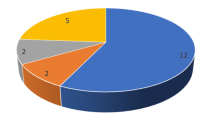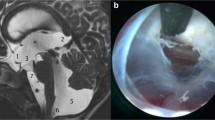Abstract
Introduction
Type I Chiari malformation (CM-I) is a common congenital malformation, often accompanied by syringomyelia. Obstruction of CSF circulation in the foramen magnum is the reason for the formation of the syringomyelia. Fourth ventricle stenting (FVS) could ensure the CSF flow from the fourth ventricle, which might represent an effective approach to achieve syringomyelia relief.
Methods
We have reviewed four cases of CM-I children who received FVS implantation from November 2021 to July 2022. Each of the patients underwent FMD. The ventricular catheter of an Ommaya reservoir (Medtronic, Inc.) was used as a stent. Duraplasty was performed with autologous fascia. Cervical MRI rechecks were routinely done 3 months later, and the clinical symptoms were followed up.
Results
Four children received FVS, including one boy and three girls, aged from 12 months to 10 years, with a mean age of 6.8 years. No major complication occurred. The syringomyelia or hydrocephalus in each patient were all attenuated, as observed on the reexamination MRI images. During the follow-up time with a mean of 10.8 months, no patient had new symptoms.
Conclusion
FVS is an effective and safe method for operation of CM-1 in children. The indications of FVS include redo-FMD, difficulties to ensure post-FMD CSF circulation patency at the foramen magnum and with obstructive hydrocephalus. A long-term follow-up duration is necessary.




Similar content being viewed by others
Data availability
The datasets used and/or analyzed during the current study are available from the corresponding author on reasonable request.
References
Lei Z-W, Shi-Qiang Wu, Zhang Z, Han Y, Wang J-W, Li F (2018) Kai Shu; clinical characteristics, imaging findings and surgical outcomes of Chiari malformation type I in pediatric and adult patients. Curr Med Sci 38(2):289–295. https://doi.org/10.1007/s11596-018-1877-2
Tosi U, Lara-Reyna J, Chae J, Sepanj R, Souweidane MM, Greenfield JP (2020) Persistent syringomyelia after posterior fossa decompression for chiari malformation. World Neurosurg 136:454–461. https://doi.org/10.1016/j.wneu.2020.01.148
Rhoton AL (1976) Microsurgery of Arnold-Chiari malformation in adults with and without hydromyelia. J Neurosurg 45(5):473–483. https://doi.org/10.3171/jns.1976.45.5.0473
Venes JL, Black KL, Latack JT (1986) Preoperative evaluation and surgical management of the Arnold-Chiari II malformation. J Neurosurg 64(3):363–370. https://doi.org/10.3171/jns.1986.64.3.0363
Park JK, Gleason PL, Madsen JR, Goumnerova LC, Scott RM (1997) Presentation and management of Chiari I malformation in children. Pediatr Neurosurg 26(4):190–196. https://doi.org/10.1159/000121190
Guan J, Yuan C, Zhang C, Ma L, Yao Q, Cheng L, Liu Z, Wang K, Duan W, Wang X, Wang Z, Wu H, Chen Z, Jian F (2021) A novel classification and its clinical significance in Chiari I malformation with syringomyelia based on high-resolution MR. Eur Spine J: official publication of the European Spine Society, the European Spinal Deformity Society, and the European Section of the Cervical Spine Research Society 30(6):1623–1634. https://doi.org/10.1007/s00586-021-06746-y
Saletti V, Farinotti M, Peretta P, Massimi L, Ciaramitaro P, Motta S, Solari A (2021) Laura Grazia Valentini; The management of Chiari malformation type 1 and syringomyelia in children: a review of the literature. Neurol Sci : J Italian Neurol Soc Italian Soc Clin Neurophysiol 42(12):4965–4995. https://doi.org/10.1007/s10072-021-05565-9
Yuan C, Guan J, Yueqi Du, Zhang C, Ma L, Yao Q, Cheng L, Liu Z, Wang K, Duan W, Wang X, Hao Wu, Chen Z (2020) Fengzeng Jian; Repeat craniocervical decompression in patients with a persistent or worsening syrinx: a preliminary report and early results. World Neurosurg 06(138):e95–e105. https://doi.org/10.1016/j.wneu.2020.02.015
John D (2010) Heiss, Giancarlo Suffredini, René Smith, Hetty L DeVroom, Nicholas J Patronas, John A Butman, Francine Thomas, Edward H Oldfield; Pathophysiology of persistent syringomyelia after decompressive craniocervical surgery. Clinical article. J Neurosurg Spine 13(6):729–742. https://doi.org/10.3171/2010.6.SPINE10200
Riordan CP, Scott RM (2018) Fourth ventricle stent placement for treatment of recurrent syringomyelia in patients with type I Chiari malformations. J Neurosurg: Pediatr 23(2):164–170. https://doi.org/10.3171/2018.7.PEDS18312s
Lou Y, Yang J, Gu H, Xu G, Ji S, Xu C, Liu Y (2022) A Clinical study on the treatment of recurrent Chiari (type I) malformation with syringomyelia based on the dynamics of cerebrospinal fluid. BioMed Res Int 2022:9770323. https://doi.org/10.1155/2022/9770323
Mathkour M, Keen JR, Huang B, Werner C, Scullen T, Garces J, Skovgard M, Iwanaga J, Tubbs RS, Dumont A, Biro E, Bui CJ (2020) Two-birds-one-stone” approach for treating an infant with Chiari I malformation and hydrocephalus: is cerebrospinal fluid diversion as sole treatment enough?. World Neurosurg 05(137):174–177. https://doi.org/10.1016/j.wneu.2020.01.188
Massimi L, Pennisi G, Frassanito P, Tamburrini G, Di Rocco C, Caldarelli M (2019) Chiari type I and hydrocephalus. Child’s Nerv Syst : ChNS : official Journal of the International Society for Pediatric Neurosurgery 35(10):1701–1709. https://doi.org/10.1007/s00381-019-04245-6
Sharma H, Treiber JM, Bauer DF (2021) Chiari 1 and hydrocephalus - a review. Neurol India 69(Supplement):S362–S366. https://doi.org/10.4103/0028-3886.332274
Sacco D, Scott RM (2003) Reoperation for Chiari malformations. Pediatr Neurosurg 39(4):171–178. https://doi.org/10.1159/000072467
Author information
Authors and Affiliations
Contributions
Peng Sun: conceptualization, methodology, investigation, writing original draft preparation, writing review and editing. Mading Zhou: data curation.Yutong Liu: investigation. Jianxin Du: supervision. Gao Zeng: conceptualization, writing review and editing, supervision. All authors have read and agreed to the published version of the manuscript.
Corresponding author
Ethics declarations
Ethics approval
The present study was approved by the Ethics Committee of Xuanwu Hospital, Capital Medical University. All procedures were performed in accordance with the ethical standards laid down in the 1964 Declaration of Helsinki and its later amendments.
Consent to participate
Written informed consent was obtained from the patients and their parents.
Consent for publication
Not applicable.
Conflict of interest
The authors declare no competing interests.
Additional information
Publisher's Note
Springer Nature remains neutral with regard to jurisdictional claims in published maps and institutional affiliations.
Rights and permissions
Springer Nature or its licensor (e.g. a society or other partner) holds exclusive rights to this article under a publishing agreement with the author(s) or other rightsholder(s); author self-archiving of the accepted manuscript version of this article is solely governed by the terms of such publishing agreement and applicable law.
About this article
Cite this article
Sun, P., Zhou, M., Liu, Y. et al. Fourth ventricle stent placement for treatment of type I Chiari malformation in children. Childs Nerv Syst 39, 671–676 (2023). https://doi.org/10.1007/s00381-022-05793-0
Received:
Accepted:
Published:
Issue Date:
DOI: https://doi.org/10.1007/s00381-022-05793-0




